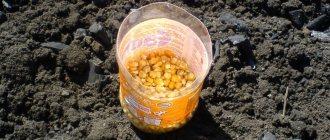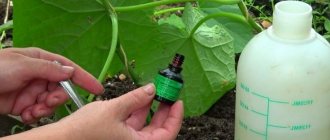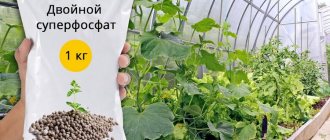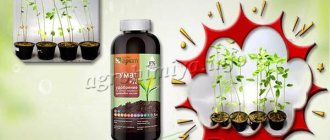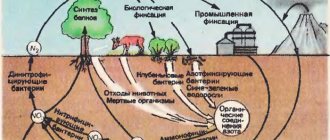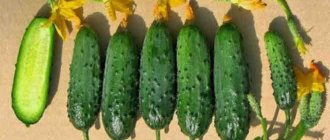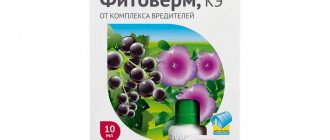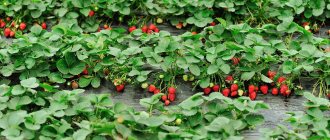Potassium is one of the main components of most mineral supplements. Thanks to it, bright and juicy vegetative parts are formed in the bushes. It enters plants in the form of salts, saturates the intercellular space and is carried along with the juice. If the edges of the leaf blade of cucumber plantings begin to darken without external signs of the presence of pests, then this fact is a sure sign of potassium deficiency. Young seedlings contain more of it. The older the bush, the less potassium is present in it. Therefore, potassium fertilizers are so important for cucumbers during the period of active growth.
What is potassium fertilizing and why do cucumbers need it?
As the name implies, this type of fertilizer includes all fertilizers that contain potassium. It can be combined with other substances to have a complex beneficial effect on the growth and development of plantings.
Potash fertilizer
Potassium fertilizer Potassium fertilizer
Potassium is essential for cucumbers due to its wide range of beneficial effects.
- accelerates intercellular exchange;
- increases resistance to moisture deficiency during drought;
- stimulates photosynthesis;
- helps to resist the influence of external pathogenic factors;
- helps accelerate protein-carbohydrate metabolism;
- increases the shelf life of fresh fruits.
Almost all types of potash fertilizers are a product of processing natural salts.
Interesting! Cucumbers are an ideal vegetable for those who want to lose weight: they are 95% water, and contain only 0.1% fat and a sugar concentration of 2.5%.
Characteristics of fertilizer
Calcium nitrate is an ideal option for feeding cucumbers. It is characterized by a high nitrogen content, which is necessary for the full development of the plant. It is produced in the form of granules or white crystals, which must be dissolved in water before use.
Attention! Vegetable growers advise choosing fertilizer in powder form - it dissolves better in water.
But not all summer residents use such fertilizer, since the phosphorus and potassium content in it is insignificant. But all the same, fertilizing cucumbers with saltpeter is necessary, because... it supplies the crop with calcium, which is important for the flowering period. Thanks to this element, the roots become stronger and the fruits ripen faster than expected.
How to understand that cucumbers do not have enough potassium
When the soil is poor, when it contains very few minerals, the level of potassium concentration also invariably falls.
This cannot but affect the state of the plantings. Potassium deficiency at home can be determined by several signs:
- The cells of young parts of the bush have greater absorption, so the deficiency affects old leaves and shoots first of all - they begin to turn yellow, become covered with a dark edging and eventually fall off.
- The color change starts from the edge and gradually spreads to the center, occupying the entire space between the veins, after which the color of the spots changes to dark, the leaf dies.
- The fall of leaves starts from the base of the stem and then moves higher.
- New leaves grow deformed, their size is much smaller than usual.
- Cucumbers take the form of a pear, thin and flaccid at the tail and lush at the base, the fruits wither, ripening is poor, the skin becomes rough, the taste deteriorates.
A lack of potassium does not cause a sharp slowdown in the growth of the bush, but leads to a decrease in the turgor of the vegetative parts due to disruption of metabolic processes. Fruits and shoots wither, leaves change shape and fall off.
Just 44 grams of potassium will help you harvest a large harvest of 100 centners of cucumbers of excellent taste and quality.
Read the article about how to make a greenhouse or greenhouse (including polycarbonate) for cucumbers with your own hands and what to choose from them.
How is potassium nitrate useful for cucumbers during the fruiting period and how to use it correctly
For normal growth and fruiting, cucumbers need complete mineral nutrition. One of the important elements for the health of the crop and the ripening of a quality harvest is potassium. It is indispensable at any stage of the growing season. For fertilizing, gardeners use agrochemicals with a high content of this microelement, among which potassium nitrate is popular.
Why do cucumbers need potassium nitrate?
Potassium nitrate is a universal fertilizer that is used on almost any soil. The trace element is contained here in a form accessible to cucumbers; there are no unnecessary impurities. Fertilizing with potassium nitrate will make cucumbers resistant to adverse factors, especially drought: the product stimulates easier absorption of soil moisture.
Regular application of the agrochemical balances the processes of photosynthesis and respiration, strengthens the root system of plants, accelerates the development and growth of green mass.
What is useful during the fruiting period?
The fertilizer contains the optimal ratio of nitrogen and potassium to obtain quality parameters for fruits:
- cucumbers do not crack;
- Fewer barren flowers are formed;
- productivity increases;
- vegetables are smooth and beautiful;
- taste improves.
Composition and properties of fertilizer
Potassium nitrate, potassium nitrate or potassium nitrate (mixture formula: KNO3) is a potassium-nitrogen agrochemical produced chemically. It is a white, odorless, crystalline powder or granules.
The mixture contains 2 active ingredients:
Nitrogen helps cucumbers grow faster and form green mass.
The main advantages of potassium nitrate over other fertilizers with the same microelement:
- does not contain chlorine, which is important for chlorophobic cucumbers;
- dissolves well in water;
- low toxic.
Potassium nitrate is flammable and explosive, so store it in a cool, dry place, away from sources of heat and fire. For the same reasons, fertilizer is not mixed with organic matter.
Important! In the room where the agrochemical is contained, maintain humidity at 60–65% so that the product does not harden.
Symptoms of potassium deficiency
With a deficiency of this element, cucumber leaves become smaller in size, become pale, turn yellow, become covered with brown spots, similar to burns, along the edges and die. The stronger the crop's need for potassium, the more spots on the plants.
The lack of the element manifests itself on the lower leaves, since potassium is quite mobile and, with a limited supply, moves to the young parts of the bushes. In hot weather, the manifestation of nutritional deficiency increases. Such cucumbers feel the need for water earlier than others and wither.
Potassium deficiency has the greatest impact on the quantity and quality of the crop. Flowering is accompanied by an abundance of barren flowers and partial death of the ovaries. The fruits grow small, uneven in diameter, and twisted.
How to prepare the solution correctly
The dissolved substance replenishes the nutritional balance much faster. Fertilizer in liquid form is used for visible signs of potassium deficiency in the form of foliar feeding.
For the procedure to be beneficial, it is important to know the exact dosage when preparing the working fluid and follow the instructions on the pack of agrochemicals.
Proportions and instructions
Basic dosages of the substance:
- For foliar feeding, more concentrated solutions are used: 25–30 g of mixture per 10 liters of water. The solution is consumed on the day of preparation.
- When watering at the root, the dosage is reduced to 15–20 g/10 l.
- For application to the soil in dry form (dry fertilizing, autumn digging of soil on the site and in the greenhouse, preparation of soil mixture for seedlings), use 15–20 g/m2.
It is better to use powder fertilizer for preparing liquid fertilizer, and granules are best applied to the soil in dry form. Granulated potassium nitrate is saturated with moisture more slowly and is stored longer.
Potassium nitrate for cucumbers during fruiting period
During the flowering period, future cucumbers are laid. How many there will be and how they will grow depends on the chosen variety, the efforts of the gardener and good nutrition. How to feed vegetables at this stage of the growing season? Potash fertilizers are applied both at the root and by spraying the plants, depending on the type of soil in the garden and the health of the crop.
Advice from experienced summer residents
Many farmers have appreciated the benefits of fertilizer for cucumbers.
Oleg, Kostroma region: “I grow cucumbers in a greenhouse for sale, so the friendly return of the harvest is of great importance.
At first I fed the cucumbers with potassium chloride at the time of fruit set, but in 2021 I decided to try potassium nitrate from. I liked that the fertilizer is already in liquid form.
Preparing the solution is a pleasure: you measure out a cap onto a bucket of water, and that’s it! The price of the fertilizer is higher than that of cheap analogues, but in my case the investment was justified.”
Olga, Moscow region: “I have acidic soil in my garden.
The fertilizer for cucumbers is good, but if you look from the point of view of agrochemistry (I am a chemist by training), then only one element is used - potassium.
Nitrogen does not work on acidic soils, but on purely alkaline soils, on the contrary, potassium will lie as a dead weight. For me, a pensioner, it is also expensive. I feed my cucumbers with ash and am happy with the result.”
Anastasia, Klin: “My husband and I are just starting to garden. The plot was given with poor soils. In the fall, manure was applied, and in the spring, cucumbers were planted under the film. The culture was growing and had already begun to bear its first fruits.
We were about to harvest this weekend when we discovered that the lower leaves had turned yellow. Whatever we did: watered, looked for pests, used home remedies, but the plants stopped growing and setting fruit. A neighbor helped, advising us to spray them with potassium nitrate.
I did everything as in the instructions. After 4-5 days, the cucumbers came to life and continued to set ovaries.”
Conclusion
Potassium nitrate is widely used over large areas and is effective both when applied to the soil and when irrigating cucumbers. The fertilizer is available in dry and liquid form. To be sure of the harvest, the product is used according to the instructions, applied during the period of flowering and fruit set. It is important to remember that an excess of nitrogen and potassium is harmful to plants, as is their deficiency.
Source: https://agronom.expert/posadka/ogorod/tykvennye/ogurets/chem-polezna-kalievaya-selitra-v-period-plodonosheniya.html
Methods for using potassium fertilizers for cucumbers
If cucumbers do not have enough potassium, they need to be fed by applying fertilizers at the root; spraying is used as an additional method. Treatment must be carried out strictly after watering with warm water not lower than +20 °C, so that mineral salts are not washed out of the soil. It is best to do this in the morning or evening hours.
Root
Soil treatment can begin after the end of seasonal work. Potassium-chlorine fertilizers are added to the soil during digging. As the snow begins to melt, the chlorine will be washed out of the soil, having an antiseptic effect, and will no longer pose a danger to plantings. You can start feeding cucumbers when they have 5 full leaves. At this stage, it is better to combine potassium with nitrogen and phosphorus. The number of applications will depend on the biochemical composition of your land. Sandy beds need more potassium due to rapid leaching; on clay soils it lasts longer, so treatment can be carried out less frequently.
Foliar
Foliar feeding is carried out by spraying the plantings. It should be started when the first pupae appear on the bushes. The interval is approximately once every 10-14 days. You can continue processing until the end of fruiting.
We recommend an article on how to grow cucumbers on a windowsill or balcony right at home.
Signs of potassium deficiency in cucumbers
If a plant is in dire need of some element, then it experiences characteristic changes in appearance.
The following signs indicate that the bushes lack potassium:
- Whips and leaves are actively growing.
- The foliage changes color to dark green.
- The leaves have a yellow border.
- Pear- and hook-shaped greens are formed.
Did you know? To successfully grow 100 centners of cucumber with fruits of excellent commercial quality and taste, you will need 44 kg of potassium.
Types of potash fertilizers and their application rate
There are several types of potash fertilizers. Each gardener chooses his own priority fertilizing, which he applies specifically to his own type of soil. From a variety of options, you can choose the one that you find more effective and easier to use and prepare. Let's look at this in more detail.
The entire large group of existing fertilizers can be divided into:
- organic;
- mineral.
They are available in different formats:
- granules;
- powder;
- crystals;
- solution.
It is best to support crops with organic fertilizers. Potassium is found in droppings, wood ash, and rotted grass. But mineral supplements often have a more noticeable effect and are used to radically solve the problem.
From a nematode
Ash
Nettle infusion
Important! If your cucumbers have wilted, turned yellow, or have any other symptoms of disease, you must take emergency measures to help your plantings. You will find useful information about the treatment and signs of diseases on our website Mister Summer Resident in article 19 diseases of cucumbers and how to treat them. For clarity, all descriptions and methods of struggle are accompanied by photographs.
As mineral potassium fertilizers you can take:
- potassium nitrate;
- potassium chloride;
- potassium humate;
- potassium sulfate.
Important! Fertilizers containing potassium are no less important for cucumbers than nitrogen-containing fertilizers. They help the plant form buds faster, speed up their flowering, which ultimately leads to an increase in the yield of the bush. The immunity of cucumbers increases, as a result of which they can more easily withstand bad weather and become more resistant to infections.
Mineral (table)
When a plant needs to be fed quickly and efficiently, but there is no time to wait, it is best to use mineral fertilizers. They are sold in any specialized store in a large assortment. It is important to remember that when working with plantings, you need to choose strictly chlorine-free options; this substance inhibits growth and interferes with the normal absorption of potassium and nitrogen.
How to dilute mineral fertilizers
Root fertilizing with mineral fertilizers should be diluted according to the following scheme:
- 3 tablespoons of granules are poured into a bucket.
- Fill it with 10 liters of water.
- Stir until the granules dissolve.
For spraying, a less concentrated solution is prepared; for the same volume of liquid, exactly half as many granules are taken.
There is no need to violate the dosage; the permissible amount of potassium for feeding greenhouse cucumbers is 10 g, for outdoor cucumbers - 15 g, and for spraying any plantings - no more than 10 g.
| Name | Description | Step-by-step instructions for use |
| Potassium sulfate | White powder. Has rapid solubility. The fertilizer contains potassium oxide, calcium, sulfur and magnesium. | Fertilizing can be done in dry form. To do this, the powder is added to the bed around the bush and sprinkled with earth on top. For every square meter, 15 g of potassium sulfate is consumed. To prepare the product, 25 g of the substance is diluted in 10 liters of water, this amount is enough to treat 4 square meters of plantings. |
| Calimagnesia | Widely used by gardeners to feed cucumbers due to its universal properties. The main components are potassium (42%) and magnesium (6.5%). There is no chlorine. | Depending on the type of soil, from 23 to 35 g of fertilizer is applied per square meter when digging the beds at the end of the season. For spraying, prepare a solution of 20 g of the substance and 10 liters of water. |
| Liquid Potassium Humate | Application is necessary to improve the taste of cucumbers; it is sold in the form of a brown liquid concentrate. | It cannot be used in concentrated form. For foliar feeding, 50 ml is diluted in 10 liters of water. Depending on the type of soil, this amount may be enough to treat from 1 to 2 sq.m. When spraying, the same solution is prepared, but it is enough to feed 10 sq.m of plantings. |
| Potassium salt | In addition to potassium (60%), it contains sylvinite and chlorine. | Works most effectively in peat and sandy soil types. It is added when digging beds in autumn or spring. 15 g of substance is consumed per 1 sq.m of soil. The plants themselves are not treated with this fertilizer. |
| Monopotassium phosphate (monopotassium phosphate) | The fertilizer contains a large number of minerals, but the main part is potassium (28%) and phosphorus (23%). It is most effective during the period of active fruiting, as it activates the formation of buds and ovaries, which affects the yield of cucumbers. | The number of treatments per season is 3-4. To nourish the soil, 30-50 g of fertilizer is added to each square meter of the bed. For root treatment, use a solution of 10 liters of water and 20 g of monopotassium phosphate, this amount is calculated for 1 hundred square meters. Spraying is carried out with a substrate of 10 liters of water and 20 g of substance. It is not recommended to simultaneously treat plants with monopotassium phosphate fertilizer and organic matter. |
| Potassium nitrate | The fertilizer contains 38% potassium, 13% nitrogen, 1% phosphorus. It is recommended to use it before fruit formation begins. | Watering the beds is carried out with a solution of 10 liters of water and 30 g of the substance, the amount is calculated per 1 sq.m. Spraying is carried out with a composition that is prepared according to the scheme of 20 g per 10 liters for treating 1 hundred square meters. bucket of water, pour it over an area of 1 square. m. For spraying - 20 g per 10 l, consumption per hundred square meters. It is not recommended to simultaneously treat plants with potassium nitrate and organic matter. |
Organic (table)
| Name | Mode of application |
| Fresh manure | Use it only in diluted form, infusing 1 kg of the substance in 10 liters of water for at least 3 days. To obtain a homogeneous mass, the solution must be stirred regularly. After the slurry has infused, another 4 liters of water are poured into it before use. |
| Bird droppings | First, a substrate is prepared from droppings and water in a 1:1 ratio, it is infused for several hours, after which it is diluted at the rate of 1 liter per 10 liters of liquid. |
| Ash solution | The ash contains 13% orthophosphate. To prepare the solution, 300 g of wood ash is diluted in 10 liters of hot water and left to brew. Treatment is carried out by watering the root space; 1 sq.m of beds will require a liter of solution; after 10 days, fertilizing can be applied again. At the initial stage of cucumber growth, you can add 12 g of urea to the solution. |
| Green fertilizers | Green fertilizer is prepared from cut grass and weeds. Almost all plants that grow on your site will do. They need to be chopped and poured into a barrel a little more than half. Fill the rest of the space with water. After this, a small amount of yeast is added, the barrel is covered with a lid or a sheet of iron and left in the sun to ferment for up to 5 days. The finished solution must be filtered; it cannot be used in its pure form. It must be mixed with water in a ratio of 1:10. You can water cucumbers with it weekly at the rate of 1 liter for each planting. There is another, simpler recipe. The weeds are placed in a regular black plastic bag, tied and left in the sun for a couple of days. After this, fill half the bucket with rotted grass and fill it with water to the brim. There is no need to dilute this substrate; it can be used immediately at the rate of 1.5 liters per bush. To ensure that cucumbers bear fruit for as long as possible, when the pupae appear, they are watered every week with an infusion of hay, which is prepared in a 1:1 ratio with water. |
Effective products of the agrochemical complex
When choosing potassium fertilizer for cucumbers in the greenhouse and in the garden, you can safely use products from the agrochemical industry. Potassium sulfate and potassium nitrate work well. The latter contains nitrogen, so it is advisable to use it in the spring to grow greenery.
Monopotassium phosphate is stirred in a bucket of water in the amount of 15 g. This volume is enough to water 3-5 bushes. An excess is harmful, so you need to dose exactly according to the instructions.
Calimagnesia contains 30% potassium, 10% sulfur, 17% magnesium and 3% chlorine. Because of the last component, it is used in the fall, for digging. Dosage - 20 g per 1 sq. m. Until spring, the chlorine will have time to evaporate.
Getting a good harvest is not difficult if you follow the advice of experienced farmers and apply fertilizers at the right time in the exact dosage.
Timing and rules for applying potash fertilizers in greenhouses and open ground
Most garden plots have rather poor soil, which without regular updating and fertilizing will not be able to nourish the plants. Therefore, fertilizers, both organic (natural) and mineral, are very popular among gardeners. Each gardener himself analyzes the condition of the soil and decides on the need to apply fertilizers.
There are general recommendations for different types of fertilizers on how to use them correctly.
- Carry out in dry, windless weather.
- Do not apply immediately before watering.
- Do the treatment in the morning or evening.
- Spraying is carried out through a fine sprayer evenly throughout the bush.
Important! The leaves must be processed carefully on each side. The more composition gets on the plate, the better the beneficial microelements will be absorbed.
Experienced gardeners recommend treating plantings several times in accordance with the approximate dates:
- First: plants are fed approximately 14 days after the first shoots appear.
- Second: carried out when flowers appear on cucumbers.
- Third: must be carried out at the stage of fruit formation.
- Fourth: cucumbers are fertilized in order to extend the fruiting period and improve their taste; this is done 7-10 days after the third feeding.
Important! If your soil is rich in mineral compounds or was updated before the start of the season, there are no disturbances in the development of cucumbers, they grow and bear fruit well, then they require a minimal amount of fertilizing. Sometimes 1 treatment is enough for the entire season.
First feeding
Organic fertilizers:
Despite their natural origin, organic matter cannot be used in its pure form, as this can destroy the plantings.
They are diluted according to folk recipes depending on the ingredients in different proportions, which are presented in the table below.
| Name | Dilution ratio (organic:water) |
| Bird droppings | 1:15, should be used immediately after preparation |
| Mullein (rotted cow dung) | 1:8, needs insisting |
| Horse dung | 1:6, must brew |
| Chopped weed grass | 1:5, infused for 5 days. |
Mineral fertilizers:
This type of fertilizer is used for quick effect and, if used correctly, will not harm your cucumbers in any way, but, on the contrary, will help you get a rich harvest.
There are several options for using it.
| Ingredients | Mode of application |
| Urea – 20 g. Superphosphate – 50 g. Water – 10 l. | The ingredients are mixed and diluted in a bucket of water, the solution is used for watering. |
| Potassium nitrate – 10 g. Superphosphate – 10 g Potassium salt – 10 g. Water – 10 l. | The components are dissolved in a bucket of water. Can be used for different types of processing. |
| Ammofoska – 5 g. | The substance is scattered over the surface of the bed, after which loosening is carried out to penetrate deeper. |
Second feeding
During this period, it is best to use a solution obtained by infusing weeds from organic fertilizers. The recipe for its dilution and the necessary proportions were given above.
For root feeding, you can use the following options for potassium mixes:
- Mix potassium nitrate (30g), superphosphate (40g) and ammonium nitrate (30g).
- Combine wood ash with superphosphate and sprinkle the soil before loosening to prepare the soil for planting.
- Dissolve wood ash (200 g) in 10 liters of warm water and leave.
Spraying can be carried out with solutions prepared according to the following recipes:
- 45 g superphosphate + 10 l water;
- 10 g boric acid + 10 g potassium permanganate + 1 liter of liquid;
- 0.5 tsp boric acid + 0.5 tbsp. granulated sugar + 1 l. warm water.
Third feeding
At this stage, it is most effective to use a herbal infusion as an organic fertilizer:
- The crushed weed is filled with water in a ratio of 1:5.
To prepare mineral supplements, you can use the following schemes:
From nematodes Potassium fertilizer
Ash
Watering the root zone of plantings:
- 10 l of water + 5 g of potassium nitrate;
- 70 g urea + 10 l water;
- 200 g wood ash + 10 liters of liquid.
Foliar treatment of cucumbers (spraying):
- 15 g urea + 10 liters of water.
Fourth feeding
In the summer, experienced gardeners strongly recommend using an infusion of hay or straw to prolong the fruiting stage, which should sit for two days.
Soda solution can be used as a mineral fertilizer. To prepare it, you will need to stir 30 g of soda in 10 liters of water, then add 1 tbsp. wood ash.
It is recommended to spray the vegetative parts of the bush with a composition prepared from 50 g of urea and 10 liters of water.
Important! Ash fertilizing contains a large amount of nutrients; it can be applied to cucumber plantings weekly.
Features of the use of potassium fertilizers during fruiting
As we have already said, a large concentration of potassium is found in young plants. Therefore, it is so important to additionally feed the plantings, especially during the period of active fruiting (July and August).
The following options are suitable as mineral fertilizers:
- 10 liters of water + 1 tbsp nitrophoska
- 0.5 l mullein + 1 tsp. potassium sulfate + 10 liters of water.
Fertilizers of natural origin can be used manure or cow manure. Recipes for preparing solutions were given above.
Foliar feeding is carried out in the following ways:
- Specialized mineral granules are diluted.
- Mix 60 g of superphosphate, 30 g of potassium nitrate, 0.4 g of manganese sulfate, 1 g of boric acid and 0.1 g of zinc sulfate.
An infusion of dry straw or hay has proven itself to be effective in prolonging fruiting. It is very easy to prepare, the recipe was described above. Spraying can be carried out weekly three times during the entire period of fruit formation.
Did you know? In many countries, cucumber is considered a dessert and is served along with other sweet treats. This is what Cypriots, Iranians and Moroccans do.
How to feed cucumbers at home
Fertilizers are applied in 2 ways:
- root;
- foliar.
The first method is considered the main one.
The second is additional. The combination of these methods is especially important during the fruiting phase. Important! Both root and foliar feedings are carried out after rainfall or heavy watering, on a non-sunny day or in the evening. Solutions should be heated to a temperature of +20°C.
Root feeding
This method of fertilizing is considered the best because it delivers nutrients to the roots faster. Dry additives are distributed over the site and dug up along with the soil. Liquid - watered between rows.
Foliar feeding
The fertilizing schedule must also include such a useful procedure for vegetable crops as foliar fertilizing. They are applied by spraying leaves and stems using a sprayer. The best time for them is cool summer.
What fertilizing do cucumbers need?
Any gardening work is undertaken with only one goal - to obtain a harvest that will be of excellent quality and excellent taste. To help cucumbers grow, develop and bear fruit normally, it is necessary to regularly feed the plantings. The most important macroelements for them are potassium, nitrogen and phosphorus.
- Potassium directly affects the number of formed flowers and ovaries, and they, in turn, determine the volume of the future harvest. Therefore, this microelement is especially important at the beginning of the fruiting period.
- Nitrogen, on the contrary, is necessary for crops at the stage of active growth until flowering. It helps the bushes gain vegetative mass. As soon as the ovaries begin to appear, it is no longer recommended to add nitrogen.
- Cucumbers need phosphorus at every stage of their growth. This microelement is necessary for the normal development and functioning of the root system. If there is too little of this substance in the soil, then difficulties arise with the absorption of nutrients.
All complex fertilizers, as a rule, also include other macro- and microelements important for cucumbers: iron, calcium, boron, magnesium, copper, zinc, sulfur, manganese and others.
You can feed cucumbers with both organic and mineral substrates; each gardener chooses his own option for caring for plantings. The main thing is to observe the dosage and frequency of treatments.
Important! Much does not mean good. Frequent fertilizing can have the opposite effect and, instead of strengthening the immune system, cause it to be impaired, which will lead to disease in the plantings.
Correct application technology
To properly fertilize cucumbers, it is important to know the technology for applying nitrate. You need to carry out the procedure:
- Before planting seedlings in garden beds. Dry matter is added to the ground. It must be poured 8-10 g into each hole and mixed well with the soil. Otherwise, you can burn the root system of the plants.
- During the flowering period. Nitrate must be diluted with water: 35 g of fertilizer per 15 liters of warm liquid. Apply 1.5 liters per bush using the root method.
- At the stage of fruit formation. In this case, foliar feeding is necessary. Spray in the morning and evening. This approach will avoid diseases and activate the immune system.
If you adhere to these rules, then there will be no problems with growing cucumbers.
Tips from Mister Summer Resident
Our portal https://mrdachnik.com recommends:
- Bitterness of fruits is the first sign of violation of watering rules and non-compliance with temperature conditions. Provide the cucumbers with plenty of warm water and make sure that the bushes are protected from the influence of temperature changes, then you will never encounter this problem.
- If your fruits on the bushes have become deformed and become more like a pear than a cucumber, then spraying with an ash solution can save the situation. It is diluted at the rate of 1 tsp per 1 liter of water.
- If you are not sure which microelement your cucumbers are lacking, then you can’t do anything wrong if you carry out complex fertilizing with mineral fertilizers.
Safety precautions when working with substances
Nitrate is not included in the group of toxic substances and is therefore recognized as safe for humans. In addition, working with it does not cause an allergic reaction. But this does not mean at all that when using fertilizing, you can neglect basic safety measures.
If you need to feed cucumbers in a greenhouse, you should work with gloves, safety glasses and respiratory masks. In addition, it is important to protect exposed skin. If nitrate gets on them, wash thoroughly with plenty of water.
Advantages and disadvantages
Fertilizing cucumbers with saltpeter helps improve the quality of the fruit, accelerate growth, strengthen the immune system, making the crops resistant to diseases and temperature changes. Most often, calcium nitrate is used, since this type is the safest for humans and is best suited for cucumbers.
Use of this fertilizer:
- improves metabolic processes and photosynthesis;
- strengthens cell walls;
- accelerates the development of green mass;
- makes roots stronger;
- increases plant immunity and resistance to fungi and bacteria;
- allows you to better tolerate temperature changes;
- increases productivity.
Calcium nitrate is suitable for all types of soil, even those with high acidity. Unlike other types of nitrate, it does not acidify the soil even more. There will be no negative consequences from this fertilizer if you use it correctly and follow the dosage. If used too often, the root system can be damaged.
Important!
Do not mix calcium nitrate with other fertilizers, especially those based on phosphates and sulfates.
Ammonium nitrate is used less frequently because it has more disadvantages. It is explosive, acidifies the soil and is not suitable for melons. Most cucumbers ripen quickly, but the minerals are absorbed slowly and have a cumulative effect. As a result, nitrates accumulate in fruits, causing harm to health. You can feed only in the first stages, before the harvest appears. It is better to use dry granules rather than a solution, burying them to a depth of 10 centimeters in the soil. Watering burns the stems, harming the plants. Many people choose this fertilizer because of the low price, but it is better to spend more and save crops.
Types of potassium humate
In modern agronomy, humate is isolated in liquid and powder form. Each variety has its own area of application. They have differences that should be considered before use.
Liquid potassium humate
This type of growth stimulator is most popular among gardeners and gardeners. The basis of the fertilizer is peat. The color of the solution is dark. Refers to concentrated products, perfect for large areas. Before use, dilute in a certain proportion in liquid at room temperature.
Compounds are extracted from peat, which are considered the basis of the resulting fertilizer. Liquid potassium humate is an enhanced action product with a positive effect. Can be used in conjunction with organic and mineral nitrogen fertilizers.
Potassium humate powder
The powdered product helps stimulate the plant's immune system. This species accelerates growth and promotes rapid ripening of fruits and berries. The powder must be diluted in liquid, following the recommendations prescribed in the instructions. The shelf life of the prepared solution is no more than 7 days.
Powdered potassium humate helps strengthen roots and develop beneficial microflora in the soil, which accelerates the formation of vermicompost, the quantity of which determines the quality of the crop. Humate can also remove heavy metals from the soil without negatively affecting its characteristics. After treatment, the soil becomes more saturated and fertility indicators increase.
Instructions for use for various crops
For grain crops
It is recommended to make a solution by pouring 200 g of concentrate into 9 liters of water. And soak the seeds in the mixture.
Mobitox-Super or Cyclomat are used for processing grains. These are special devices that are used for treating seeds.
Spraying of wheat, rye, barley, oats is carried out during tillering and flowering. Spraying millet, sorghum - during tillering and the appearance of simple cluster inflorescences. Buckwheat is processed when buds form and after a few weeks. And corn - when the petals are thrown out and when the corn begins to bloom.
For vegetables and herbs
How to make a solution:
- Vegetable and herb seeds are treated with potassium humate before sowing. To do this, make a solution of 100 ml and 1 liter of clean water, and then leave the soaked seeds in it for 24 hours.
- Place potato tubers in the solution before planting. To do this, make a solution of 10 ml of fertilizer and 1 liter of water. Then soak the tubers for 10-12 hours. Soak the bulbs in the same way before planting.
- For watering seedlings 1 tbsp. Pour a boatload of the drug into a ten-liter bucket of clean water and water.
- If you want to water vegetable crops (for example, tomatoes and other crops), then pour 50-100 ml of liquid into a ten-liter bucket of water. Pour 3-10 liters per 1 m², the number of liters per 1 m² depends on which plants you want to water.
- If you want to water the greens, then pour 50-100 ml of fertilizer into a ten-liter bucket of water, pour 3-10 liters per 1 m². As a result, the greens will have an excellent taste, their resistance to bad weather conditions and diseases will increase, and they will grow faster.
- For spraying, make a solution by pouring 50-100 ml of the composition into a ten-liter bucket of water and spray the crops, spending 1.5-3 liters per 100 m².
During the growing season, apply fertilizer 2-6 times. Treat beets, cauliflower and white cabbage, zucchini, squash, and carrots with the mixture 4 times per season. And feed the cucumber and tomato bushes 3-4 times during the growing season. Treat greens 2-6 times per season.
For fruit and berry crops
Fertilizer is applied in early spring before the formation of flower buds, then when the first ovaries appear, and a third time when the fruits ripen. Fertilizer helps fruits accumulate sugar.
How to make a solution:
- For seeds, bulbs and tubers, make a solution by pouring 50-100 ml of the drug into 1 liter of clean water. Pour the seeds into this solution; they should lie in it for 24 hours. Soak the bulbs and tubers in a similar solution for 10-12 hours.
- For watering, dissolve 50-100 ml of the composition in a ten-liter bucket of water. Pour 3-10 liters per m², the number of liters depends on which plant you want to water.
- For spraying, make a similar solution and use 1.5-3 liters per 100 m².
Fertilize strawberries with this composition 3 times:
- first treat the seedlings before planting;
- then with active leaf growth;
- 3 times - in the fall, to prepare and feed strawberries for winter. Pour 10 ml of fertilizer into a ten-liter bucket of water. This amount is enough for 5 m² of bed. It is recommended to use humate together with ammonium nitrate.
For garden flowers
Such plants are fed with potassium humate in the spring. Perennial flowers at the beginning of the growing season, and annuals when all the shoots appear. Then the flowers are fertilized every 2-3 weeks, 3-6 times in total.
How to make the solution:
- To treat seeds, pour them into the solution and leave for 24 hours, and bulbs and tubers for 12 hours. Make the solution like this - pour 50-100 ml of the drug into 1 liter of clean water.
- For watering, make the same solution, use 3-10 liters per m².
- To spray flowers, pour 50-100 ml into a ten-liter bucket of clean water and use 1.5-3 liters per 100 m².
For indoor plants
There is no humus in containers with indoor flowers. Therefore, fertilizing indoor flowers makes their growth more active, they form a larger number of buds, and the flowers become larger.
From early spring to September, feed the flowers once every two weeks. And from October until the end of winter, fertilize once every 1.5 months. Make the composition by pouring 5-100 ml of fertilizer into 1 liter of water, spray the flowers with this solution. Water with a similar solution.
But it is better to fertilize orchids with a special composition of Bona Forte, which contains potassium humate.
When to use
In early spring:
- They dig up the areas and add dry powder to the soil.
- Before sowing seeds or planting seedlings and seedlings, water the beds.
- Soak seeds and tubers before planting.
- Before picking and transplanting into open ground or greenhouses, the seedlings are sprayed.
During the entire growing season:
- Water at the root (no more than once a week).
- Spray the plants (no more than once every 2 weeks).
- Soak the cuttings.
- Spray the roots of the seedlings before planting.
- Water the compost heap (4-6 times per season).
Autumn:
- If there are chemicals or pesticides in the soil, potassium humate powder or solution is added to it.
- When transplanting, the roots of the seedlings are soaked in the solution.
Watch the video! Potassium humate. What is humate and what does it give to the soil? Application
Specifics of using fertilizers during fruiting
Quite often, gardeners apply fertilizer mixtures during fruiting of cucumbers. During this period, the following composition is prepared: take 30 g of nitrophoska, ten liters of water and 5 g of potassium sulfate. During active fruiting, it is advisable to use the foliar method. In this way, it will be possible to extend the period of fruiting and harvest products with improved qualities.
Important microelements for cucumbers
Cucumbers need a comprehensive approach to nutrition. Among the microelements necessary for their growth and fruiting are zinc, manganese, boron, phosphorus, and nitrogen.
- Nitrogen is required by the plant at each stage for the growth of green mass and fruit development.
- Phosphorus provides high productivity and protection from pests, increases endurance.
- Boron is necessary for the formation of ovaries.
The most important element in the nutrition of cucumbers is potassium. It promotes the development of the root system, making the plant stronger and healthier.
Storage and Security
Main danger: fire. It can occur at high temperatures or through contact with substances that cause fire. Therefore, it is best to store supplies in dark, dry rooms, tightly packed in airtight containers. Optimal packaging: polyethylene or paper, the main thing is to ensure the integrity of the packaging. Keep the fertilizer away from heat and direct contact with sunlight: this may cause an explosive reaction.
Another problem: nitrate accumulation. Melon crops accumulate them in cells more actively than others, so application should be completed at the stage of fruit formation. It is also not recommended to use saltpeter in combination with organic fertilizers: this will increase the acidity of the soil.
You may be interested in:
How to prepare fertilizer from eggshells for a bountiful harvest of cucumbers and tomatoes The value of eggshells as a fertilizer is due to the high content of calcium and other micro- and...Read more...
When working, you must follow basic safety precautions:
- Mix solutions away from residential areas.
- Use protective equipment: mask, respirator, goggles, gloves.
- Do not exceed the recommended concentration of the substance so as not to burn the skin and plants.
- Water in doses, without affecting the stems and leaves: they can only be sprayed with a light solution.
- If the solution gets on your skin or mucous membranes, rinse the affected area and consult a doctor.
It is better not to use ammonium nitrate for cucumbers: it is more active, causes the accumulation of nitrates in melons and can damage delicate stems and leaves. It can be neutralized by preparing calcium nitrate from it. The resulting concentrate must be diluted and used for watering and spraying crops.
